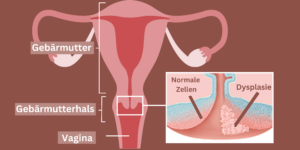Dysplasia means abnormal cell growth in various parts of the body. This article provides you with important information about the different types of dysplasia and how they can be treated.
The most important facts at a glance
- Dysplasia refers to abnormal cell growth and can occur in different parts of the body, with varying degrees of severity.
- An important HPV infection is a risk factor for dysplasiawhich in particular Cervical cancer can favour the development of the
- Early detection and treatment of dysplasia are crucial; regular screening and innovative diagnostic methods play an important role in this.
What is dysplasia?
Dysplasia is a medical term that refers to malformations or changes in cells and tissues characterised by atypical growth and loss of differentiation. This abnormal development or growth of cells, tissues or organs can occur anywhere in the body. An example of this is aplasia, where an organ is underdeveloped even though the organ anlage is present.
Dysplasia is categorised into different levels of severity: mild, moderate or severe. These levels describe the degree of cell abnormality. Dysplastic cells differ from normal cells in their immature structure and irregular organisation, which leads to an impairment of their function. This can have far-reaching consequences for health, as the affected cells can no longer fulfil their normal functions.
There are many different types of dysplasia that can affect different areas of the body. Whether in the skin, genitals or other organs, understanding the specific form and severity of the dysplasia is crucial for proper treatment and prevention.
Early detection: symptoms of dysplasia
The impact of dysplasia on health can vary depending on its location and severity. Some people may not notice any symptoms, while others may develop serious health problems. Common symptoms include unusual changes in the affected tissues or organs.
At cervical dysplasia, which affects the cervix, abnormal vaginal bleeding may occur, especially after sexual intercourse. Other signs include unusual vaginal discharge, which is often the first warning sign. These symptoms are important for early detection and should not be ignored.
Vulvar dysplasia can be accompanied by itching or pain in the vulvar area. Changes to the skin, such as discolouration or growths, can also indicate dysplastic processes. These symptoms are particularly unpleasant and significantly affect the quality of life of those affected.
In some cases dysplasia can also occur in other parts of the body, such as the eye or genital area. Symptoms such as itching, pain or skin changes may occur. It is important to take these signs seriously and seek medical advice to ensure an accurate diagnosis and treatment.
Causes and risk factors for dysplasia
The causes of dysplasia can be varied and include genetic factors, environmental factors and exposure to toxins or infections. Genetic predisposition plays an important role, but external influences can also increase the risk.
HPV infection is a particularly significant risk factor. The frequency of HPV infections is highest in sexually active young people, which increases the risk of developing dysplasia. HPV infection increases the risk of developing precancerous lesions and various types of cancer, especially cervical cancer. HPV infection is the cause of around 40% of vulvar cancers.
A weakened immune system, as is the case with HIV infection significantly increases the risk of HPV-associated tumours. Chronic HPV infection is also considered to be one of the main factors in the development of certain head and neck tumours. Genital warts can often appear as an external sign of dysplasia in the genital area.
Diagnostics of dysplasia
The diagnosis of dysplasia is crucial for early detection and treatment. Imaging techniques such as MRI and CT are traditionally required to identify tumours before tissue samples are taken. Histological findings may indicate precancerous lesions, which is important in microscopic examinations of tissue.
Since 2020, new guidelines for screening for cervical cancer in Germany have emphasised the combination of HPV tests and cytological examinations. These new methods have significantly improved the detection of histological abnormalities. Regular gynaecological check-ups, including PAP tests and HPV tests, are crucial for early detection of changes to the cervix.
In addition to traditional methods, there are also new approaches such as the Liquid biopsy, circulating free DNA (cfDNA) and circulating tumour cells for early detection. These methods are promising, but their accuracy still needs to be further improved.
Treatment options for dysplasia
The treatment of dysplasia can be both drug therapies as well as surgical interventions depending on the severity of the disease. Moderate and severe dysplasia can be classified as precancerous lesions, which makes them precursors of malignant tumours.
The choice of treatment method depends on various factors, such as the individual's state of health and the specific type of dysplasia. It is important that the doctor chooses the best method for the patient in order to achieve the best results.
In some cases, new experimental approaches to the treatment of dysplasia are being researched in clinical trials. These innovative methods could offer less invasive and more effective treatment options in the future.
Prevention of dysplasia - strengthen the immune system!
The HPV vaccination is recommended to reduce the rate of infection with the dangerous HPV types associated with cancer. Ideally, this vaccination should be given before the first sexual contact in order to maximise the protective effect. A reduction of 85 per cent for high-risk precancerous stages of cervical cancer is possible after HPV vaccination.
It is also important to to establish a strengthened immune system. Healthy lifestyle habits, such as a balanced diet and regular exercise, can reduce the risk of various diseases, including dysplasia. These measures are easy to implement and have a major impact on overall health.
Research and new developments
Current research approaches to dysplasia are focussing on innovative diagnostic methods and treatment options. Scientific studies show that new imaging techniques can improve the early detection of dysplasia. can improve.
Future perspectives in dysplasia research include the expansion of the genetic analyses for better risk assessment. These analyses could enable a more precise diagnosis and more individualised treatment approaches in the future.
New therapeutic approaches that allow less invasive treatments are also a focus of current research. These developments could revolutionise the treatment of dysplasia and significantly improve the quality of life of those affected.
Psychosocial effects of dysplasia
The diagnosis of dysplasia can lead to significant psychological distress for those affected, including anxiety and depression. These emotional challenges should not be underestimated and often require professional support.
Social isolation and stigmatisation are common problems faced by people suffering from dysplasia. Socialising with other sufferers can help to overcome this isolation and develop a better understanding of the condition.
Professional counselling and support groups provide a platform for sharing experiences and can reduce feelings of loneliness. This support is crucial in helping those affected to deal with the emotional and social challenges and find a stable footing.
Summary
Dysplasia is a complex topic that encompasses many different aspects. From the causes and symptoms to diagnostics and treatment options, we have provided a comprehensive overview. The importance of prevention through HPV vaccination and Healthy lifestyle habits for a strong immune system was also considered.
In conclusion, knowledge about dysplasia and its treatment options is crucial in order to be able to act proactively. Stay informed and take care of your health - it is the most valuable asset we have.
Frequently asked questions
What is dysplasia?
Dysplasia is an abnormal development or growth of cells, tissues or organs characterised by atypical growth and loss of differentiation. This phenomenon can occur frequently in various tissues and is often an indication of more serious health problems.
What symptoms can occur with cervical dysplasia?
Abnormal vaginal bleeding, especially after sexual intercourse, and unusual vaginal discharge can occur with cervical dysplasia. These symptoms should be taken seriously and clarified by a doctor.
How can dysplasia be diagnosed?
Dysplasia can be diagnosed by imaging (such as MRI and CT), histological analyses, HPV tests and cytological examinations. A comprehensive diagnosis is crucial for the early detection and treatment of this disease.
What risk factors increase the likelihood of dysplasia?
Genetic factors, environmental factors, exposure to toxins or infections such as HPV and a weakened immune system increase the likelihood of dysplasia. It is important to consider these risk factors in order to take appropriate preventive measures.
How can dysplasia be prevented?
Dysplasia can be prevented by the HPV vaccination and healthy lifestyle habits such as a balanced diet and regular exercise. These measures significantly reduce the risk of dangerous HPV infections.





